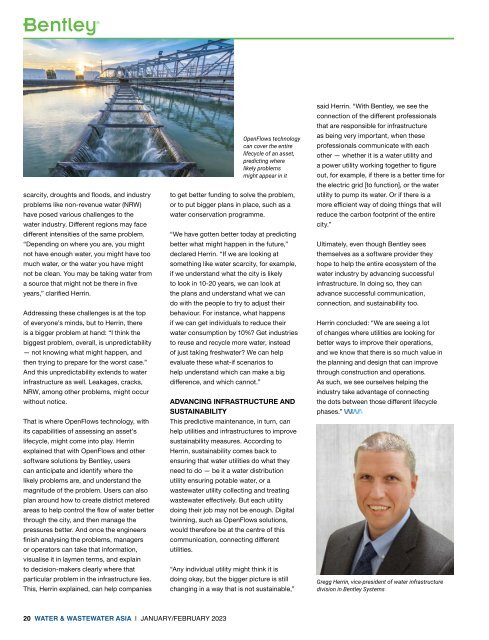Water & Wastewater Asia January/February 2023
Water & Wastewater Asia is an expert source of industry information, cementing its position as an indispensable tool for trade professionals in the water and wastewater industry. As the most reliable publication in the region, industry experts turn this premium journal for credible journalism and exclusive insight provided by fellow industry professionals. Water & Wastewater Asia incorporates the official newsletter of the Singapore Water Association (SWA).
Water & Wastewater Asia is an expert source of industry information, cementing its position as an indispensable tool for trade professionals in the water and wastewater industry. As the most reliable publication in the region, industry experts turn this premium journal for credible journalism and exclusive insight provided by fellow industry professionals. Water & Wastewater Asia incorporates the official newsletter of the Singapore Water Association (SWA).
Create successful ePaper yourself
Turn your PDF publications into a flip-book with our unique Google optimized e-Paper software.
scarcity, droughts and floods, and industry<br />
problems like non-revenue water (NRW)<br />
have posed various challenges to the<br />
water industry. Different regions may face<br />
different intensities of the same problem.<br />
“Depending on where you are, you might<br />
not have enough water, you might have too<br />
much water, or the water you have might<br />
not be clean. You may be taking water from<br />
a source that might not be there in five<br />
years,” clarified Herrin.<br />
Addressing these challenges is at the top<br />
of everyone’s minds, but to Herrin, there<br />
is a bigger problem at hand: “I think the<br />
biggest problem, overall, is unpredictability<br />
— not knowing what might happen, and<br />
then trying to prepare for the worst case.”<br />
And this unpredictability extends to water<br />
infrastructure as well. Leakages, cracks,<br />
NRW, among other problems, might occur<br />
without notice.<br />
That is where OpenFlows technology, with<br />
its capabilities of assessing an asset’s<br />
lifecycle, might come into play. Herrin<br />
explained that with OpenFlows and other<br />
software solutions by Bentley, users<br />
can anticipate and identify where the<br />
likely problems are, and understand the<br />
magnitude of the problem. Users can also<br />
plan around how to create district metered<br />
areas to help control the flow of water better<br />
through the city, and then manage the<br />
pressures better. And once the engineers<br />
finish analysing the problems, managers<br />
or operators can take that information,<br />
visualise it in laymen terms, and explain<br />
to decision-makers clearly where that<br />
particular problem in the infrastructure lies.<br />
This, Herrin explained, can help companies<br />
to get better funding to solve the problem,<br />
or to put bigger plans in place, such as a<br />
water conservation programme.<br />
“We have gotten better today at predicting<br />
better what might happen in the future,”<br />
declared Herrin. “If we are looking at<br />
something like water scarcity, for example,<br />
if we understand what the city is likely<br />
to look in 10-20 years, we can look at<br />
the plans and understand what we can<br />
do with the people to try to adjust their<br />
behaviour. For instance, what happens<br />
if we can get individuals to reduce their<br />
water consumption by 10%? Get industries<br />
to reuse and recycle more water, instead<br />
of just taking freshwater? We can help<br />
evaluate these what-if scenarios to<br />
help understand which can make a big<br />
difference, and which cannot.”<br />
ADVANCING INFRASTRUCTURE AND<br />
SUSTAINABILITY<br />
This predictive maintenance, in turn, can<br />
help utilities and infrastructures to improve<br />
sustainability measures. According to<br />
Herrin, sustainability comes back to<br />
ensuring that water utilities do what they<br />
need to do — be it a water distribution<br />
utility ensuring potable water, or a<br />
wastewater utility collecting and treating<br />
wastewater effectively. But each utility<br />
doing their job may not be enough. Digital<br />
twinning, such as OpenFlows solutions,<br />
would therefore be at the centre of this<br />
communication, connecting different<br />
utilities.<br />
OpenFlows technology<br />
can cover the entire<br />
lifecycle of an asset,<br />
predicting where<br />
likely problems<br />
might appear in it<br />
“Any individual utility might think it is<br />
doing okay, but the bigger picture is still<br />
changing in a way that is not sustainable,”<br />
said Herrin. “With Bentley, we see the<br />
connection of the different professionals<br />
that are responsible for infrastructure<br />
as being very important, when these<br />
professionals communicate with each<br />
other — whether it is a water utility and<br />
a power utility working together to figure<br />
out, for example, if there is a better time for<br />
the electric grid [to function], or the water<br />
utility to pump its water. Or if there is a<br />
more efficient way of doing things that will<br />
reduce the carbon footprint of the entire<br />
city.”<br />
Ultimately, even though Bentley sees<br />
themselves as a software provider they<br />
hope to help the entire ecosystem of the<br />
water industry by advancing successful<br />
infrastructure. In doing so, they can<br />
advance successful communication,<br />
connection, and sustainability too.<br />
Herrin concluded: “We are seeing a lot<br />
of changes where utilities are looking for<br />
better ways to improve their operations,<br />
and we know that there is so much value in<br />
the planning and design that can improve<br />
through construction and operations.<br />
As such, we see ourselves helping the<br />
industry take advantage of connecting<br />
the dots between those different lifecycle<br />
phases.”<br />
Gregg Herrin, vice-president of water infrastructure<br />
division in Bentley Systems<br />
20 WATER & WASTEWATER ASIA | JANUARY/FEBRUARY <strong>2023</strong>


















